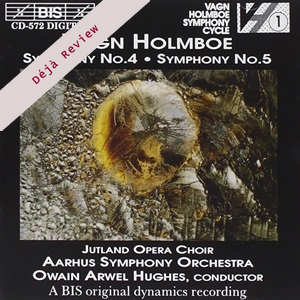
Déjà Review: this review was first published in November 2002 and the recording is still available.
Vagn Holmboe (1909-1996)
Symphony No 4 Sinfonia Sacra, Op 29 (1941 rev 1945) *
Symphony No 5, Op 35 (1944)
Jutland Opera Choir *
Aarhus Symphony Orchestra/Owain Arwel Hughes
rec. 1992, Musikhuset, Aarhus, Denmark
BIS-CD-572 [53]
Holmboe’s Symphonies Four to Seven were written over the period of a decade, between 1941 and 1950. The Fourth was written in memory of his brother Ebbe who was a member of the Danish resistance and had been killed in a concentration camp and the text Holmboe employs is his own, translated into Latin. As so often with him, a commanding and forceful momentum is immediately established, propelled by a side drum and trumpet whereas the second subject is cooler, sparer but with insistent and unsettled direction – with a prominent piano part. Holmboe’s texts chart a passage from darkness to light and also encourage from him a deliberately archaic turn of phrase, one that imbeds in the work a sense of the indissoluble fabric of time. The second movement opens with pizzicati tread; quizzical and saturnine material launches a funereal tread. Women’s voices intone the Terra jacet deserta and the music becomes increasingly ardent and desperate with a recurrence of the first movement’s ostinato passage. The remarkable third movement begins in galvanizing fashion but soon twists on its course with an unaccompanied fugal passage. Truly evocative and once more binding the historical and contemporary by means of utter naturalness and extending, broadening and deepening the work’s universality. The fourth movement is characterised by a lightening, an increasing simplicity of utterance – delicate strings, wan woodwind figures, the choral “archaisms” still intact. The fifth, a Gloria, is led by brass in the ascendant, percussion to the fore and high woodwind and increasingly shrill contributions from the choir. There is something almost frantic about the vitae et mortis – as well there might be in the circumstances – that almost overwhelms the internal syntax of the movement. Some generously pliant wind writing and winding lower strings counter theme redirect the movement to a more affirmatory ending. The sixth and final movement manages to rid the work of ambiguity and disjunction in its overwhelming embrace of the Laudate Dominum and the conclusion is one of joyful praise, one reached however through the most difficult of journeys.
The Fifth is a three-movement work – fast, slow, fast – dating from 1944 (the composer wrote “War year 1944” in the score). I know of few other composers who have the means by which immediately to establish such a convincing sense of direction as Holmboe. Densely coiled and symphonically argued with the highest of skill, the first movement charts a grim and determined course, employing his favoured technique of metamorphosis. Ostinato violin figures and shrieking high woodwind add their own aural layering to a sense of steadily accumulating implacability and aggression. This is unremitting music and Holmboe claimed it was fired by his feelings of outrage at the Germans’ occupation of Norway. The slow movement opens with an admixture of uneasy strings and blackened brass. The vicious outburst at 4:38 is the logical outcome of the material barely concealed earlier on and the whole movement in fact is in a sense one of barely suppressed emotion. Only towards the end is there any semblance of consolatory sonority – with the high wind writing conjoining in weird congruity in a perplexing, irresolvable conclusion. The third movement has a fugato inspired start. Now however the brass fanfares become more affirmatory, the sense of congestion and suffocation lessens as Holmboe clarifies and delineates orchestral strands with particular care. He expands the work in terms of orchestral colour and redirects it towards structural pillars that lead on to the inexorable peroration and so the work, exhausting, concise, ends in courageous triumph.
It was a triumph too for Holmboe and particularly the Aarhus Orchestra and Owain Arwel Hughes. This is another staging post in their superb Holmboe cycle. If you think him one of the greatest symphonic composers of the century – and there’s little reason to believe he wasn’t – then acquisition of the entire BIS cycle is a matter of necessity. Because these are – truly – necessary works.
Jonathan Woolf
Buying this recording via a link below generates revenue for MWI and helps us keep free access to the site




















